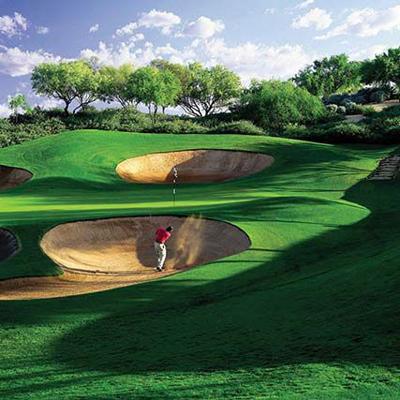Technology such as graphite shafts and lightweight titanium heads have also changed the size of the club head. The strength of these once space-age materials now allow the face of the club to be thinner, increasing the spring-like effect of the clubface on to the ball and the distance the ball will travel. In fact, in an effort to maintain the challenge of the game, the USGA has recently limited the spring-like effect, known as the coefficient of restitution (COR), to .83 and the maximum club head size to 460-cc.
Callaway Golf Company
2180 Rutherford Rd Carlsbad, CA - (760) 931-1771
A pioneer in golf technology, Richard C. Helmstetter began his career as a billiard cue designer, and later became chief club designer for the Callaway Golf Company at its headquarters in Carlsbad. With the help of Glenn Schmidt, the company’s master toolmaker, the company developed the original Big Bertha driver using a large volume (190-cc) steel club head. The Big Bertha grew to 290-cc in 1997. Through the Big Bertha, Callaway contributed to a page in the history of the swing.
The local company continues to develop technology that changes the game. Available this month, the RAZR Fit Xtreme Driver is the newest product in Callaway technology. Headlining the adjustable driver is a powerful new Speed Frame Face Technology that optimizes stiffness and stress distribution across the face for more efficient energy transfer.

Callaway Golf RAZR Fit Driver
[ Callaway Golf RAZR fit driver. ]
"The RAZR Fit Xtreme Driver is worthy of its extreme designation," said Dr. Alan Hocknell, SVP of research and development at Callaway Golf. "We worked tirelessly to improve on the best distance characteristics of our longest drivers, and the result is incredibly fast ball speed off the Speed Frame Face, plus the lowest CG of any adjustable driver in golf. It will not be matched."
Speed Frame Face Technology is a combination of VFT and Hyperbolic Face Technology, resulting in stress distribution across the titanium face for a larger, more consistent sweet spot and increased ball speed. It also saves weight that is redistributed in the clubhead to improve the center of gravity (CG) and maximize inertia, which leads to optimized ball flight and forgiveness. Also featured is a tighter bulge radius than its predecessor, providing a more preferred look at address, along with more consistent sidespin and dispersion.

Callaway Irons 2013 FINE magazine
[ Callaway Golf RAZR irons. With a vast variety to select from, your sure to find a set that can improve your golf game. ]
The crown of the RAZR Fit Extreme is a forged composite of more than seven million turbostratic carbon fibers, which is lighter than titanium. Its OptiFit Hosel technology now allows one to manually adjust the shaft, grip and loft on this driver. Callaway maintains that the personal adjustment on the face angle—open, closed or square—improves the accuracy and trajectory of the shot from either the tee or the fairway. The OptiFit Weights can also be adjusted to shift the clubhead’s CG to promote either draw or neutral ball flights. Golfers now dial in their ideal settings and hit drives like never before.
The RAZR Fit Xtreme features two tour-grade shafts as stock offerings. The primary shaft, the Aldila Trinity, combines Aldila’s three patented design technologies—RIP, S-Core and Micro Laminate—into a single shaft design. A secondary offering, the Matrix 7M3 Black Tie, is a heavier, lower launching, lower spinning option for higher head speed and higher spin players. Neither shaft will be modified from the product available in the aftermarket.
So in effect, changing your driver will amend a bad swing, which proves yet again, technology may soon surpass human ability. Mary, Queen of Scots—who legend has it was a huge fan of golf—would have given her head for this driver.
Taylor Made-Adidas
Another respectable authority on golf technology also headquartered in Carlsbad is TaylorMade-Adidas, which continues to offer stiff competition in the market. Gary Adams, the inventor of metalwood, founded TaylorMade in McHenry, Ill., in 1979, acquired by Adidas in 1997.
Via a global webcast on Oct. 23, Mark King, current president and CEO of TaylorMade, officially introduced what he calls the biggest iron innovation to date: the RocketBladez. These irons boast a new technology that promotes high-launching, long-straight and quick-stopping performance for golfers of all abilities.

TaylorMade RocketBallz Driver 2013 FINE magzine
[ TaylorMade RocketBallz Driver represents the lastest in new golf technology. ]
The key technology is its "speed pocket," which was inspired by the distance-enhancing benefits of the RocketBallz fairway woods and Rescue clubs. Altogether, the RocketBladez set consists of 11 individually designed clubheads, each tailored in size, shape and feature to maximize distance and control.
"Metalwoods have advanced tremendously since TaylorMade introduced the first one in 1979," King said. "There hasn’t been a significant advancement in irons since the perimeter-weighted cavityback, which was introduced more than 50 years ago."

TaylorMade RocketBladez Irons 2013 FINE magazine
[ TaylorMade RocketBladez Irons. ]
The speed-pocket advantage is especially effective on impacts made low on the face. TaylorMade studies indicate that 68 percent of iron shots by amateur golfers are mishits below the center of the face. The speed pocket helps to increase ball speed and distance on those low-face mishits significantly. Tour professionals will also benefit from the RocketBladez Tour model also being offered. "We created RocketBladez irons for amateurs, but when our Tour Staff pros tried it, they wanted it," King explained.
"The RocketBladez also boasts an ultra-thin clubface with improved inverted cone design. The speed pocket is filled with specially formulated polyurethane developed by 3M that quiets vibration without slowing or inhibiting the flex of the pocket. It also keeps debris out. Both models consist of strong, maraging stainless steel. Not only is it 11-percent thinner, but it adds up to 10 COR points to the face compared to Burner 2.0 irons and promotes less drop-off in ball speed on impacts low on the face, where the majority of iron mishits occur. That means the COR low on the face is higher than it has ever been in a TaylorMade iron.

Taylormade RocketBladez Irons 2013 FINE magazine
[ TaylorMade RocketBladez irons face. ]
Both amateur and professional RocketBladez models have low and centered CG location and external and internal hosel-bending notches. The irons have now been fine tuned to a lower CG by 2.5 mm and centered location on the face by shortening the hosel to save weight and then redistributed to all the strategic areas within the head. Also featured, is a distinct external notch on the outer, rear side of the hosel and internal notch inside that together makes it easy to bend the head to change the lie angle.
On the Apollo 14 mission on the moon in 1971, Alan Shepard fitted a six-iron head to the handle of a lunar sample collection device and launched two golf balls over a mile into the distance. A similar shot on earth would hang in the air 25 to 30 seconds, and travel just 900 yards. But with the improvements created every year, today’s technology may soon overcome the lack of atmosphere on the moon.








(0) comments
We welcome your comments
Log In
Post a comment as Guest
Keep it Clean. Please avoid obscene, vulgar, lewd, racist or sexually-oriented language.
PLEASE TURN OFF YOUR CAPS LOCK.
Don't Threaten. Threats of harming another person will not be tolerated.
Be Truthful. Don't knowingly lie about anyone or anything.
Be Nice. No racism, sexism or any sort of -ism that is degrading to another person.
Be Proactive. Use the 'Report' link on each comment to let us know of abusive posts.
Share with Us. We'd love to hear eyewitness accounts, the history behind an article.